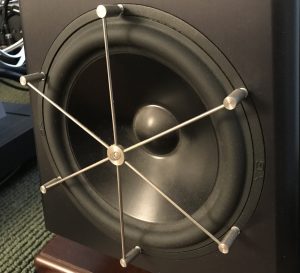
Many a long year ago, there was (really; truly; I kid you not!) an audiophile product called EarWax™.
Apparently following the same logic that came up with the idea for "board wax" (used on surfboards to make the board and its rider glide more smoothly across the waves), a dab of this stuff was to be applied—by fingertip or Q-Tip®—to the opening of each ear, and was claimed to lubricate the passage of sound into the auditory canal and, from there, on to the inner ear, for a (so its makers said) "more complete and enjoyable listening experience."
I never tried it, and can't, therefore, tell you if it actually worked, but it was one of a whole range of those weird-sounding, unlikely, but not utterly impossible products that make our hobby so baffling; so fraught with controversy; and, ultimately, so much fun.
In fact, board wax apparently does work for surfers, and I'm told that a great many of them use it. So why shouldn't a product like EarWax™ do the same for audiophiles? Beats me; but I doubt that it does: Although the concept seems reasonable enough on its surface, I suspect that to compare the motion of a surfboard and its rider across water with the passage of minute changes in air pressure through our auditory canals misses the boat entirely.
EarWax™ was one case where a product that sounds like it ought to be reasonable probably isn't. There are lots more. Think, for example, of all the small things (little bowls, "magic" dots or stickers, pieces of wood) that are claimed, just by being placed in your listening room, to make an important improvement to the sound of your system. The only things that these can possibly do are to either absorb, re-direct, or somehow "transform" the sonic energy that impinges on them, and—even if they were to be 100% efficient in doing whatever they do—given their general size, the total percentage of the energy they could affect must always, as compared with the total sonic energy in the room, be insignificant.
There are other things that, while common sense declares that they could never possibly have any real sonic effect, do so anyway. The most obvious of these is a system's cables: It really does seem that "wires is wires," and that they—as long as they're properly connected, not "shorted," properly shielded, and of sufficient gauge—ought not to have any sonic effect at all, but that's simply not the case. Being a past, and once-again, cable manufacturer, though, (first XLO, and now RSX), I understand that anything I might say about cables could be taken as self-serving, so I'll give a different example, instead.
How's this one? Try it: it can be surprisingly effective. Do you have any medium-to-large size vases, jars, or similar empty vessels as decoration in your listening room? Either take them out or fill them with something. Marbles, pebbles or gravel are recommended. (Water will eventually either evaporate or start growing things). The reason for doing this may seem to make no "common sense" at all, but is solidly based in science, and can be clearly audible.
Semi-enclosed volumes of air, like the inside of a vase or jar, act as "Helmholtz resonators" (think of the air in a wind instrument like a flute, a bassoon, or an organ pipe) and, when "stimulated," will audibly resonate at a fundamental frequency determined by their volume. The "stimulus" is the sound from your speakers when you play your system, and if those containers are open, they'll "sing along" with your music at a volume level proportional to the closeness of the frequency of resonance to the frequency of the music being played.
The solution? Either close them, get rid of them, or fill them with something to remove or reduce the resonant volume. Do it! While it doesn't seem reasonable at all, you will hear the difference!
Finally, in addition to the things that seem like they ought to work and don't, and the ones that seem like they ought not to work, and do, there are all the ones that seem like they ought to work, but audiophiles can never really quite decide if they work or not.
Possibly the most famous of these was the green ink "treatment" for CDs popular back in the 1980s and 90s. This called for using a permanent marker to color all the way around the edge of a CD. The claim was that this would absorb refracted laser light bouncing around inside a CD as it was being played and would, thereby make for more precise playback, more detail, and better sound. Because of the color of the light from the CD player's internal laser, green was said to be the best color to use, and a couple of companies even went so far as to offer pens of a particular shade of green claimed to optimize the effect.
Just about everybody did this for a while, and Peter Belt, the well-known British eccentric or innovator (take your pick), even claimed to improve the process by using a "proprietary" purple pen that was so effective that just making a one centimeter mark with it on the edge of a CD would do the job as well as fully painting the edge of the disc with green.
Belt's claims finally went too far when he said that the one centimeter purple mark would work on LPs, too, and that just marking one disc or LP would improve the sound of your entire library.
Our hobby abounds with things that have had audiophiles cheerfully in hot debate for nearly three-quarters of a century. We're still arguing over which sounds better, tubes or solid state, analog or digital? Horns, boxes, or planar speakers?
All of the sides on all of the issues either can, or claim to be able to, provide facts and solid reasoning to support their positions. Ultimately, though, the decision is yours to make, using your own ears and your own personal standards for judgment. Tests can be wrong, or even test the wrong thing. Reviewers can be biased or mistaken. High price is not necessarily an indication of high value. Yours is the only decision that matters—even if you have wax in your ears.





































